
 |
|
|
#1 |
|
Member
Join Date: Dec 2004
Location: Sint-Amandsberg (near Ghent, Belgium)
Posts: 830
|
I recently found this knife on ebay. From time to time, similar knives are offered, mostly of a poor quality. But when I received this particular piece, I noticed it was really well made.
It is a Bou-saâdi knife from the town-oasis Bou-saâda in Algeria. Here a link to situate this town : http://lexicorient.com/e.o/bou-saada.htm The knife comes with a simple scabbard of two pieces of wood, covered with some kind of leather. The handle of my piece is also made of wood, with some copper winding as decoration. What's especially interesting is the blade. It's very well forged and razorsharp. Upon examining this piece, I found out that it was probably made from a file (look at the last pic). I guess it dates from the Algerian War of Independence (1954–62). Probably it was brought back by a French soldier. Measurements : total length in sheath : 30 cm length of blade : 18,5 cm width of blade near the handle : 2,2 cm the back of the blade near the handle is 6 mm thick  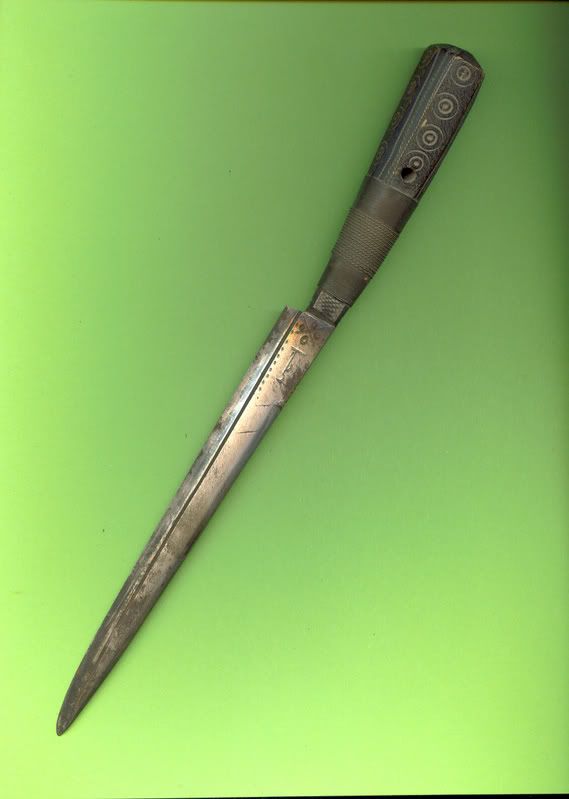 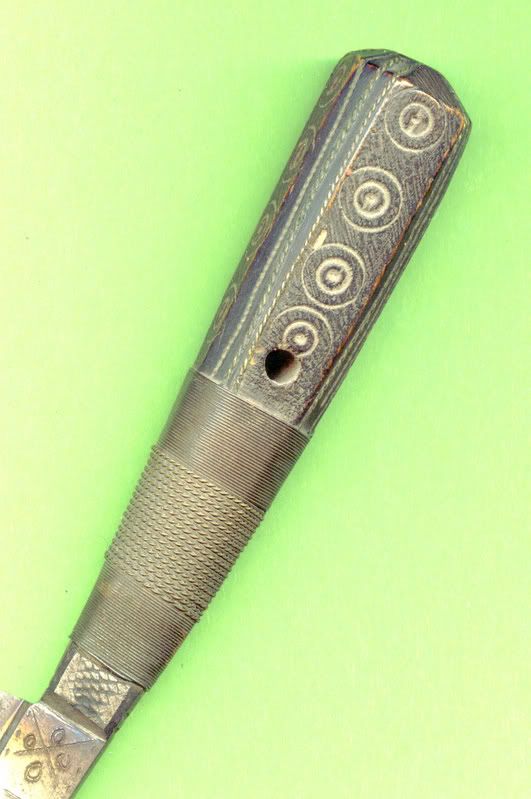 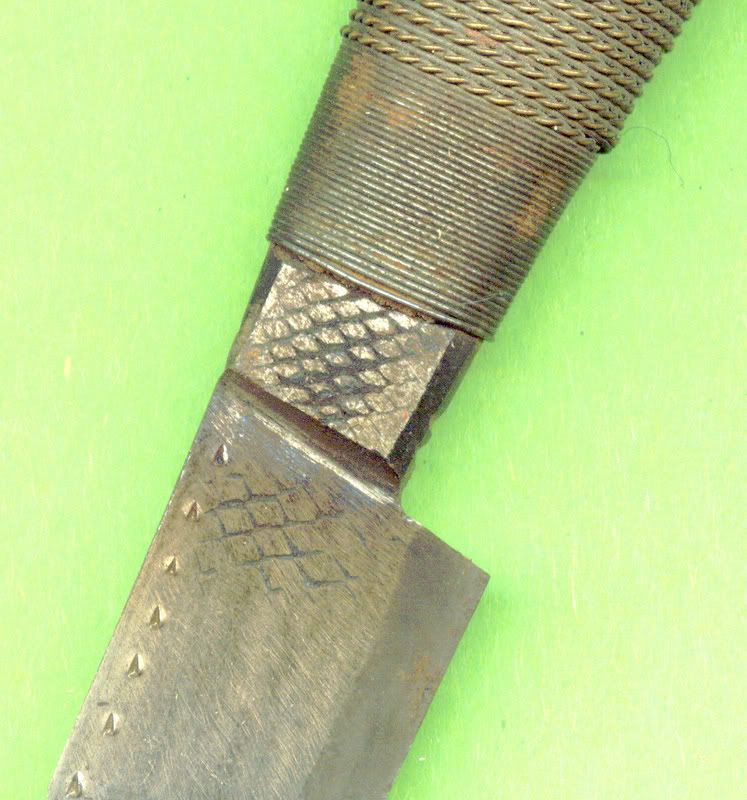
|
|
|

|
|
|
#2 |
|
Member
Join Date: Jan 2006
Location: Kent
Posts: 2,658
|
Hi Freddy,
I think I have your knife's brother, also made from a file . My blade is 18cms long, approx. 6mm thick blade . Very similar decoration, very sharp and well made.....unfortunately no sheath  . .So is mine a Bou-saâdi knife ? |
|
|

|
|
|
#3 |
|
Member
Join Date: Dec 2004
Posts: 184
|
Both nice Khodmis !
 I have several,and as far as I can tell all of mine are made from files,I wonder where all of them came from? 
|
|
|

|
|
|
#4 |
|
Member
Join Date: Dec 2004
Location: Sint-Amandsberg (near Ghent, Belgium)
Posts: 830
|
Katana, Justin,
I think that it's far easier using steel from files than actually making your own steel. As to the shape of these knives, yes they are all quite similar. I see that on Katana's knife, some copper dots are added. Nice touch. My guess is that this kind of knife is a functional piece, with a simple design. I've seen examples with were much simpler in decoration, but still with a sharp blade. Recently, a bou-saâdi knife with a curved handle was offered on ebay. Perhaps different types exist, who knows ? |
|
|

|
|
|
#5 |
|
Member
Join Date: Jan 2006
Location: Kent
Posts: 2,658
|
Freddy,
I agree these are functional ....not only because of the thickness/sharpness of the blade but also the design of the handle. Mine (when looking down on the spine of the knife) has one side of the handle (the left side) in line with the blade....the right side has a different angle making it fatter than the right. It seems that mine is designed for a right-handed person ...as it sits nicely in the palm and the blade points straight forward Using it left-handed puts the blade at a slight angle and is not as comfortable. Last edited by katana; 11th February 2007 at 01:57 AM. |
|
|

|
|
|
#6 |
|
Member
Join Date: Jul 2005
Location: Toronto, Canada
Posts: 1,242
|
Hello,
I recently stumbled apon a book about Algeria from the turn of the century (20th that is) It showed the type of knives being produced in Bou Saada, and it was the straight variety only, as the ones shown in this thread. The curved type are recent and are made for the tourist market. The blade geometry and the excessive decorations on the blade point to this. Here is mine: http://www.vikingsword.com/vb/showthread.php?t=2140 And an ebay one: http://www.vikingsword.com/vb/showthread.php?t=3849 I'd really like to get the authentic variety, I thoroughly dislike my tourist one  Hi David, I think the misalignment of the handle on your example is purely a result of simple craftsmanship. I think the tang was not fitted precisely, only "crudely". I also think that distinctions of right-handed or left-handed may not apply to knife fights, as a fighter would change from one hand to another depending on the situation. Being limited to one hand only would be a terrible disadvantage I think. Emanuel |
|
|

|
|
|
#7 |
|
Member
Join Date: Jan 2006
Location: Kent
Posts: 2,658
|
Hi Freddy,
I also noticed that the remaining file teeth 'pattern' is visible in the same areas on each knife. The blade is quite thick , so if a 'file' knife was undesirable they could easily remove the evidence (teeth pattern) by making the blade slightly thinner. Could it be like a 'quality' mark ....so that you could easily see what the blade was made from.  If that is the case I can only assume that 'file' knives were desirable by the locals. If that is the case I can only assume that 'file' knives were desirable by the locals.
|
|
|

|
|
|
#8 | |
|
Member
Join Date: Jan 2006
Location: Kent
Posts: 2,658
|
Quote:
The knife is well crafted and a simple mistake of cutting the 'slot', to accept the tang of the knife at the wrong angle, seems unlikely to me. The handle would be the cheapest and easiest componant to replace if it had been wrongly cut. If you could 'handle' the knife....I am confident that you would agree that this 'alignment' was deliberate. Regards David |
|
|
|

|
|
|
#9 |
|
Member
Join Date: Dec 2004
Location: Sint-Amandsberg (near Ghent, Belgium)
Posts: 830
|
Katana, I don't think that my bou-saâdi knife is off-centre. Look at the pics
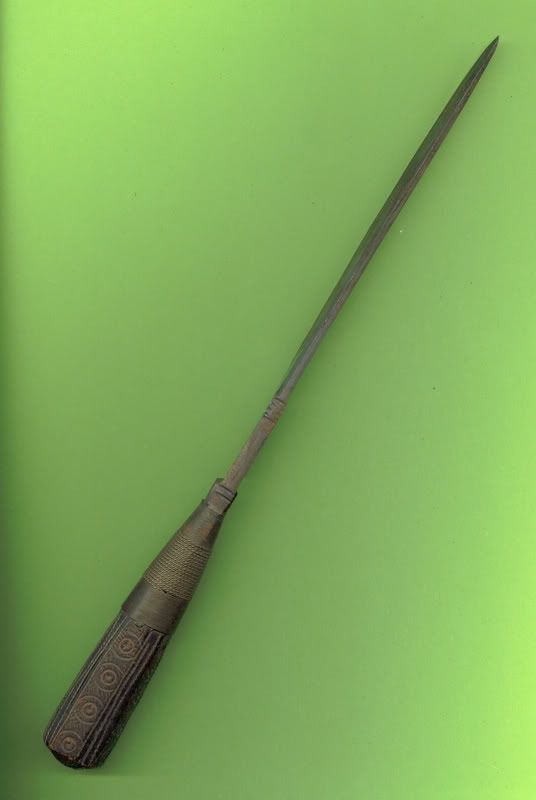 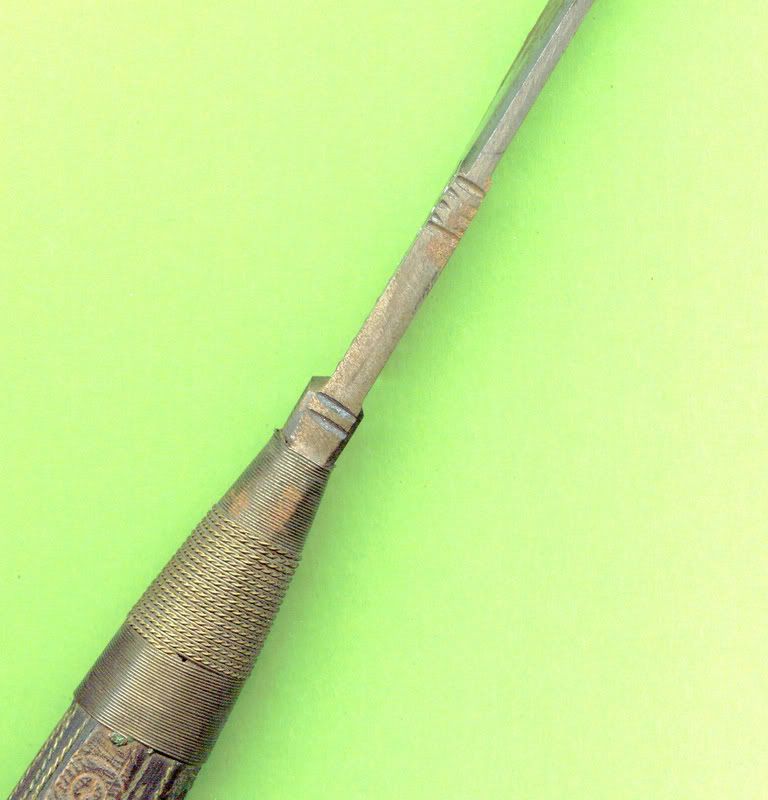 Perhaps it is like Manolo wrote, just some crude craftmanship. Your remark on the file marks could be correct, though. Perhaps it's a kind of a signature. |
|
|

|
|
|
#10 |
|
Member
Join Date: Dec 2004
Location: What is still UK
Posts: 5,940
|
This one seems not to be made from a file. It is also straight.

|
|
|

|
|
|
#11 | |
|
Member
Join Date: Dec 2004
Posts: 1,712
|
Quote:
I have an Afghan sabre that follows the same right handed approach as well. I dont think its an unusual concept, I think I have seen similar in Nazi daggers? Whether historicaly this is for hand fit or perhaps just greater comfort in a piece worn against the body I have no idea. But to me it seems to serve both functions. Spiral |
|
|
|

|
|
|
#12 |
|
Member
Join Date: Jul 2005
Location: Toronto, Canada
Posts: 1,242
|
I would be very interesting if these weapons were indeed crafted with specific dexterity in mind. Would people then visit the smith and have a custom-made knife to fit them, or would they get whatever was available/ready-made? To me it just seems like an excessive trouble to got through to fit low-end utilitarian knives to people's hands. But then that's my present conception, and things could certainly have been different in the right context. Whatever the explanation David and all, you now really make me desire one of these knives...they're quite beautiful
Emanuel |
|
|

|
|
|
#13 |
|
Member
Join Date: Jul 2005
Location: Toronto, Canada
Posts: 1,242
|
Ah another question...were these worn suspented by a baldric or tucked into a sash?
|
|
|

|
|
|
#14 | |
|
Member
Join Date: Jan 2006
Location: Kent
Posts: 2,658
|
Quote:
Hi Spiral, thanks for your input..I appreciate it  I am certain that the handle/blade alignment is deliberate. Perhaps individual craftsmen had differing traditional 'slants' on the finished knife. Some straight...some 'offset'...I personally find 'my' handle gives extra control and the 'swollen' right hand side of the handle fits perfectly into the closed palm , the 'pommel' also sits nicely in the 'heel' of the palm (of the clenched fist when holding the knife) This actually means that when the knife is used in an upswept stabbing motion and a hard target is hit....the hand does not slide up to the blade (usually a cross guard would prevent this). In the spirit of 'physical' archeology.....I put this to the test (safely) Using 3/8" plywood as a target I forcefully used the knife (in an upward stabbing motion) The knife penetrated very deeply, on one occasion causing splintering on the reverse side from the impact. My hand never slipped or moved on impact, usually on a knife/dagger without a guard my hand would have slide up to the blade. I have concluded that this knife is trully functional and well made.....It survived totally unscathed .... but ...I do not know how this knife would be handled or held by the people that produced it.... although anotomically the grip I had on the knife felt right. |
|
|
|

|
|
|
#15 |
|
Member
Join Date: Dec 2004
Posts: 1,712
|
Thankyou Katana, just an observation on my part, from what i have seen.
I am happy to be corrected by the more learned or indeed " true belivers" but I understand traditional islam looked down on any left hand use other that of cleaning ones backside, with the pain of hell for those who didnt follow the code? anD wrote, eat, stroked, offered freindship etc with the left hand. I understand some liberal progresive islamacists now teach left hand use is acceptable. I doubt if Algeria has that that many modern progresives who can speak out loud without fear though. So my deduction is right hand use would & design would be higher than even genetic potential demands. I am glad your blade was tempered katana to withstand your testing,, some weapon steel is quite soft even though genuine. {works for draw cuts & sharpens easily.} Same as some tourist crap is tempered. Ill have to keep my eye open for another good example for one of these. SpiraL |
|
|

|
|
|
#16 |
|
Member
Join Date: Dec 2004
Location: Ann Arbor, MI
Posts: 5,503
|
I am not sure left-handedness was particularly opposed by Islam as such.
The custom in Arab countries (and may be Muslim in general ) is that people eat with their right hand and wipe themselves after defecation with an object held in the left one. This is a smart hygienic precaution in an area with little water. Wasn't it Sir Richard Burton who almost lost his head while traveling to Mecca dressed like an Arab, but using the wrong hand? Are there any specific anti-Southpaw  injunctions in Islam? injunctions in Islam?Western societies were not much different; many positive human qualities are connected with the right hand: righteousness, dexterity etc. And a malicious person is called sinister (left in Latin). |
|
|

|
|
|
#17 | |
|
Member
Join Date: Dec 2004
Posts: 1,712
|
Quote:
 } & paper as a unclean process? } & paper as a unclean process?Must admit I havent asked the couple of muslims that I know though. Just second hand info from there English wives. Well old Richard must have had an intresting life!  So should we all So should we all  Spiral |
|
|
|

|
|
|
#18 | |
|
Member
Join Date: Jan 2007
Posts: 181
|
Quote:
 Making weapons (or even tools for that matter) that conform to a person's grip is nothing new, not is it restricted to only high-end items. I have a low-priced Bowie with staghorn scales that was definitely shaped to be right-handed over left. I popped the pins and flipped the scales and now have an extremely serviceable knife. It wouldn't surprise me at all that some knifemakers in Bou-Saadi would shape their knives for the dominant hand. Not that hard to do, and it would make them more popular. |
|
|
|

|
 |
|
|